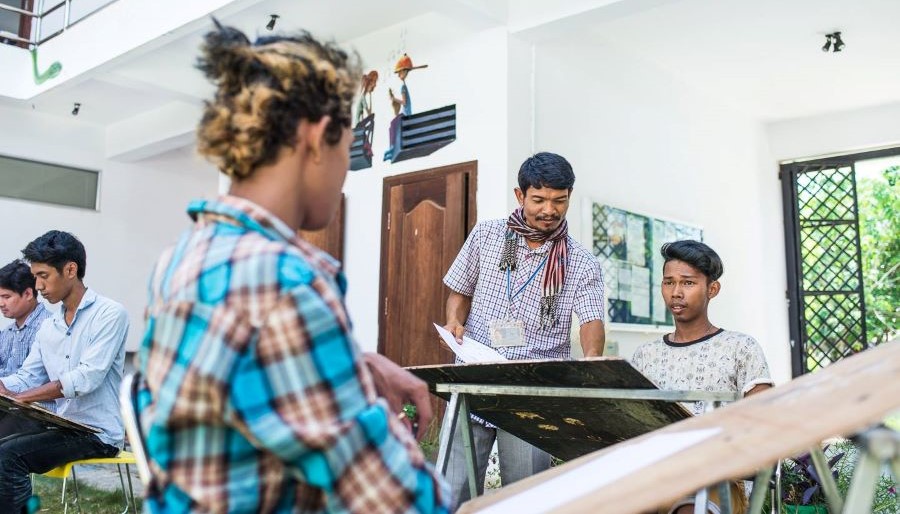Arts are at the center of everything we do at Phare Ponleu Selpak.
Phare’s mission, vision, values – and even its name – are all based on the idea that creativity and artistic expression are inherently valuable. We also believe that the visual and performing arts create well-rounded, educated members of any community, whether in Battambang, Berlin, or Buenos Aires.
In Cambodia, where so many different artists, musicians, writers, and performers were wiped out in the Khmer Rouge, the arts also have an essential role in carrying forward Cambodian culture and creative practices to the next generation.
But in today’s fast-paced, tech-oriented world of generative AI, some people are asking: Why do the arts matter? What are they good for? Do we still need to teach our students art, music, theatre, and the like?
As we celebrate the 30th anniversary of Phare Ponleu Selpak this year, the answer is a resounding: Yes!
To learn more about this fundamental truth to our organization – why the arts do matter – we asked three of Phare’s co-founders to share their thoughts on what makes the arts important and why, especially in today’s world, every student should study them.
Keep reading to hear from Lokru Vutha, Lokru Det, and Lokru Lao (“Lokru” means “teacher” in Khmer) who are all three still actively involved at Phare Ponleu Selpak.
Why do you believe the arts are important?
Lokru Vutha: The arts are extremely important. Drawing – first in caves and then on paper – has been part of humanity since prehistory.
I realized this during the Cambodian Civil War when Véronique Decrop – a French volunteer at Site 2 Refugee Camp – taught me and many other children how to draw. When I draw, I can express my feelings and let out pent-up emotions and imaginary things in my head. Wars build mental illness in people, but artistic expression dispels it. I discovered this when I was about 11 or 12 years old, and ever since, drawing has been meaningful to my life.
Additionally, before all things are created, they must start from sketching. Before making something, you have to imagine, think, draw, and then make what you draw come to life.
Lokru Det: Arts are alive in every facet of a person’s body.
Arts also define culture. A nation without arts and culture fails to qualify as a country because you can’t identify their origins and what values they share. The arts are crucial in determining the soul of a country.
Lokru Lao: The whole world is linked together by the arts. Everything – including humans, nature, and animals – are connected to art. We cannot live without the arts.
Eating, sleeping, and daily activities were made with the taste of the arts. Even though we can’t always see it, art is inherent and found inside all of us.
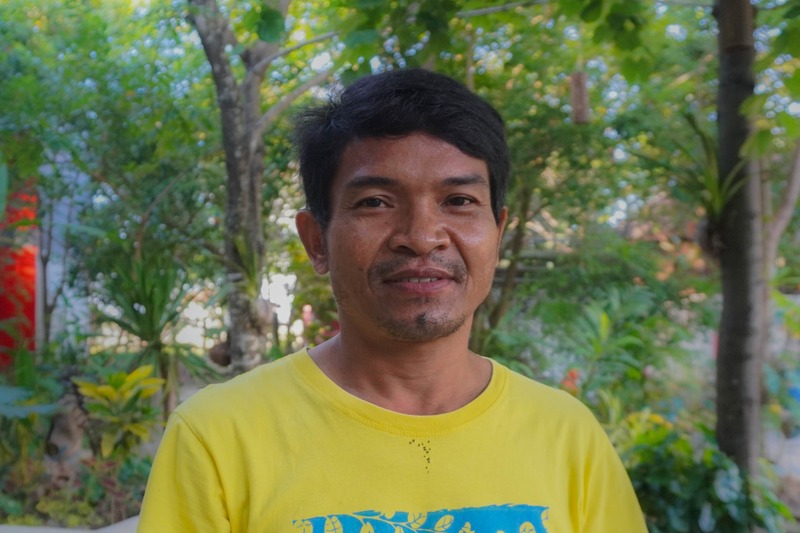
Lokru LON Lao, Co-Founder of Phare Ponleu Selpak and teacher at Phare Visual and Applied Arts School. Photo credit: Olivia AUDO.
After the Cambodian Civil War, what has been the role of the arts in healing pain and trauma?
Lokru Det: During the civil war, many people immigrated to the borders with their memories full of images of suffering and horrible acts of cruelty. At first, there were no fun activities nor time for self development in the camps.
Children displaced by the war were very disadvantaged; they had no opportunity to grow up in a loving household. They lost their rights to education and childhood. Their only priority was fleeing and surviving.
I was fortunate enough to have the opportunity to study art at Site 2 Border Camp. Veronique, our teacher, asked us kids to put whatever pressures we kept in mind onto paper. Since we were all in the same boat, talking to each other wouldn’t help much, but drawing did. It was a free drawing class, so there were no rules or norms.
In order to gain strength and learn self-defense during that time, I also studied other skills like acrobatics and martial arts. I began to feel brave and mentally strong because of such arts. We continue this initiative at Phare with the younger generations to keep up the therapeutic tradition of the arts.
Lokru Lao: Personally, I regard the arts very highly. If you carry artistic qualities, you also have a true understanding of reality as well as life. In your mind, art can be the medicine to cure oneself when you’re dealing with a problem. Art doesn’t only benefit the mind, though – some people can use art to heal various other problems.
Lokru Vutha: When PHARE (the predecessor to Phare Ponleu Selpak) was started in 1986, everything had been lost during the civil war. At Site 2 Border Camp, we worked hard to recreate and preserve the arts. Individual people helped build back their arts and culture.
The camp stretched about eight or nine kilometers in diameter. It wasn’t really big, but through art classes, we could still manage to preserve theatre, music, song, dance, and the art of drawing.
From 1975-79, people in the camp had seen disturbing images so often that they got used to what they saw. They had no idea the toll this took on their mental health.
The camp had psychologists checking on people’s mental health and observing at the camp, but it didn’t really work well. The most effective way of healing people at that time was through the arts. Every week, people at the camp would watch exhibitions of theatre, dance, singing, and film. They got a lot of happiness and relief from these exhibitions.
Arts do heal people’s trauma, but they don’t heal everything. Even with art, some people still struggle to solve their mental problems.
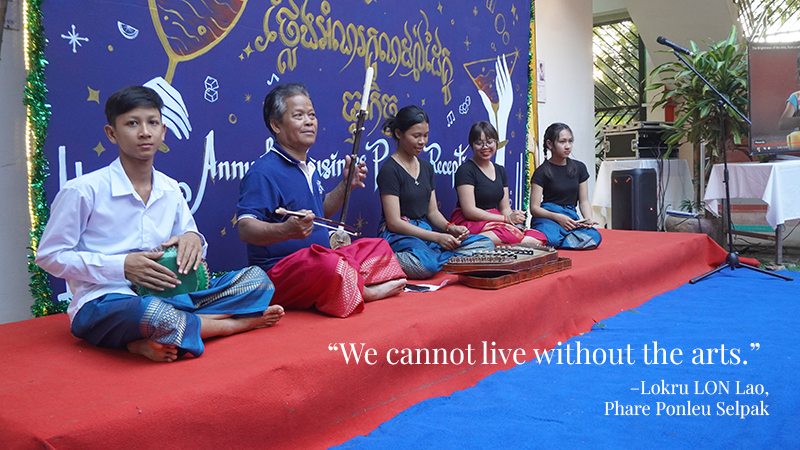
Photo Credit: Bryce MERKL SASAKI
Modern society places a lot of emphasis on STEM (Science, Technology, Engineering, & Mathematics) over and above the arts. What are your thoughts on this trend? Are the arts still necessary?
Lokru Lao: The arts and sciences are parallel and sometimes blend together. No matter how far science advances, the arts will always be pulled along because science relies on art. Their combined use delivers innovation and excellent outcomes.
Lokru Vutha: We are seeing a worldwide trend where the more science develops, the more arts get left behind. Fewer and fewer people are majoring in the arts field, which is a shame because understanding art supports all other skills.
We cannot say that any majors are better than arts, nor can we say arts are better than any other fields of study. If you are working with technology, you also need arts to help you to plan, design, brainstorm, and collect information. And when working on art, technology can be extremely helpful, like in animation, for example. Both disciplines rely on each other, so we can’t say one of them is more important.
Lokru Det: In today’s world, technology is very advanced, and youth aren’t really into arts. Young people are interested in anything that gives quick results. They’re interested in trendy, new things. They aren’t really aware that art is an essential component of life. Regardless of how far or how much technology advances, we can always incorporate the arts into it. The choice is ours.
Generative AI is really intelligent and trendy, and it is attracting a lot of attention in the arts right now. However, the arts won’t be abandoned. It is important to understand how to improve art by adapting and integrating it with technology. The arts continue to matter despite the advancement of technology. They support one another.
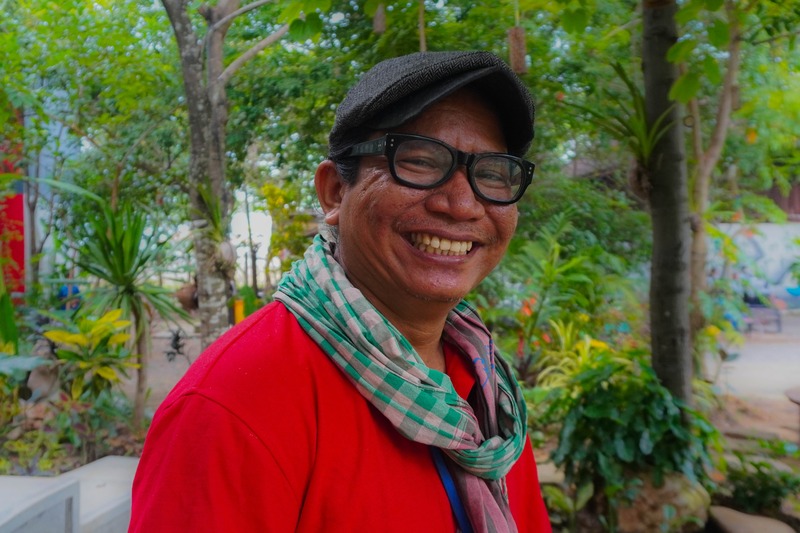
Lokru TOR Vutha, Co-Founder of Phare Ponleu Selpak and Director of Phare Visual & Applied Arts School. Photo credit: Olivia AUDO.
Oftentimes, it’s difficult for art graduates to find steady jobs. Should students continue to learn art if it may not be as employable as other fields of study?
Lokru Vutha: Almost everywhere in the world, artists don’t find many jobs to do, but if they have a specific artistic specialization, they tend to have a better job and a more successful career.
Not all artists become renowned while they are living; some become famous after they die, and some never become famous at all. Different people have different interests and talents, and we should respect all these paths because love and passion for what you do is what pushes you to keep working on it.
Many people around the world work for a salary, not out of passion and love. In Cambodia, some people learn a major from a university just to find a job that pays well, even though they may not be passionate about their job. These people often give up on their job as they get older, and it may be too late to switch professions.
My theory as a whole is that whatever your major is – IT, business, art, medicine, etc. – it has its own value as long as you’re passionate about it. It’s important to work at a job you love and be happy to live with it.
Lokru Lao: We’ve been working with arts since right after the war ended, and there have been many struggles along the way. Imparting the knowledge of arts to members of our society is challenging as they aren’t always aware of the core value of it. I don’t want to blame anyone for their lack of appreciation for the arts, because the majority of our people are more concerned with daily survival or finding work to support their families.
As we look at the employment field, there aren’t many markets that need the arts. As a result, it’s often hard for us to engage businesses and potential students in the value of art.
Later on, when there are better art markets in Cambodia and foreign countries that we partner with, arts can become a more employable profession. We’ve designed the school curriculum at Phare Ponleu Selpak based on what the market demands. When students begin to learn and see their artistic potential, they become highly focused, aspirational, and diligent through the arts.
Lokru Det: When the older generations of Cambodians were re-settling and beginning their families, the country had just gained independence and was still recovering from the war. Cambodia was still economically unstable, so individuals were more interested in survival than education and artistic passion.
Since so many people suffered from lack of education during the war, older generations prioritized the prosperity of their families over the arts. As a result, they didn’t understand the value of an arts education, so they were reluctant to support their children in studying art.
Some students learned on their own without telling their parents. Once they had gained skills, they had the courage to show their parents who were often amazed at what they saw.
Engage your children in the arts at home by having them read books, watch performances, or do other artistic activities in their free time. It’s important to impart artistic knowledge to children.
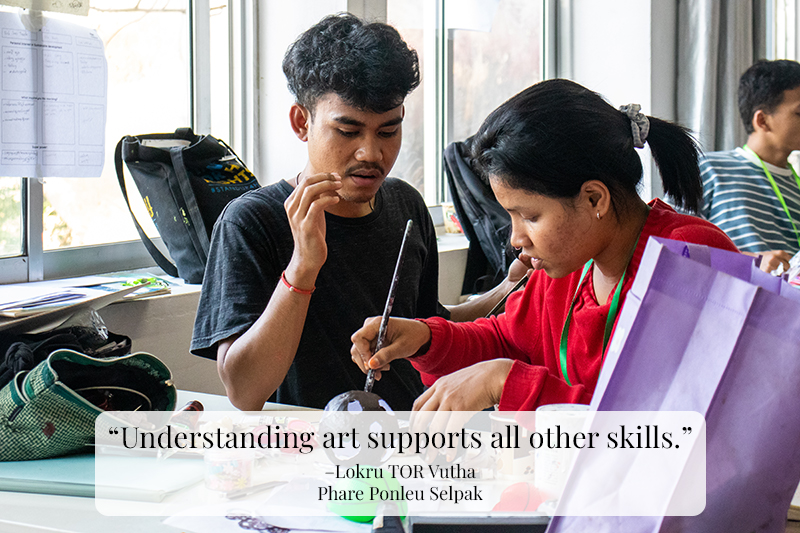
Photo Credit: Juliette DELORON
What role does Phare Ponleu Selpak play in raising up Cambodian artists and fostering an artistic community?
Lokru Lao: Phare plays a crucial role in the arts and in Cambodian society as a whole. I say this because of the lack of education and artistic knowledge of our people post-Civil War. They lack a solid fundamental knowledge of the arts. Both the public schools and the teachers are inadequate in this regard. This is why we use Phare Ponleu Selpak to spread artistic awareness and to impart knowledge and vocational skills.
Lokru Det: The goal of Phare is to transform lives through the arts. In order to preserve Khmer arts in some form, Phare works with the Cambodian government, particularly the Ministry of Culture & Fine Arts, to promote Khmer arts.
Because of the civil war, Khmer arts were reduced to almost zero. But at Phare, we have started to restudy, preserve, and create Cambodian arts again. For the arts we already have, we keep practicing to develop them, and we let the new generations learn about the arts and cultural heritage of the nation’s soul.
Phare Ponleu Selpak also offers support to vulnerable, at-risk children. By providing professional skills, we use the power of the arts to change their lives. But we also provide general education in tandem with artistic skills, which cannot be overlooked. Arts and education are equally important. Alongside education, students’ artwork becomes more creative and inventive, resulting in future potential achievements for arts and society.
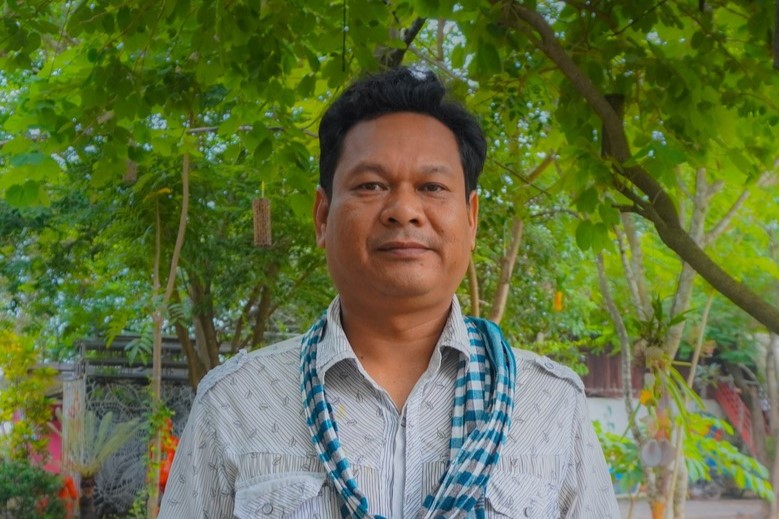
Lokru KHUON Det, Co-Founder of Phare Ponleu Selpak and Director of the Phare Performing Arts School. Photo credit: Olivia AUDO.
Anything else you’d like to add or share?
Lokru Det: You have to sacrifice a lot as an artist, especially your personal time. You need to keep pursuing it as your passion even though you do not always get paid for it.
Give your work your all and impart your knowledge to future generations. If you don’t contribute, no one else will help to promote our arts and culture. Through the arts, we can pass our national identity down to the next generation.
Lokru Lao: Because I love the arts, I will never stray from this path. The human, animal, and natural worlds are all aspects of existence that are explored via the arts.
I have a strong passion for the arts and want to promote them to Cambodians who are interested in learning them. I want to pass on my knowledge until I retire. I want to convey to my people that the arts are priceless.
If you study art, give it your all, and you will see how important the arts are. In the midst of our flourishing society, I urge the next generation of Cambodians to continue pursuing the arts.
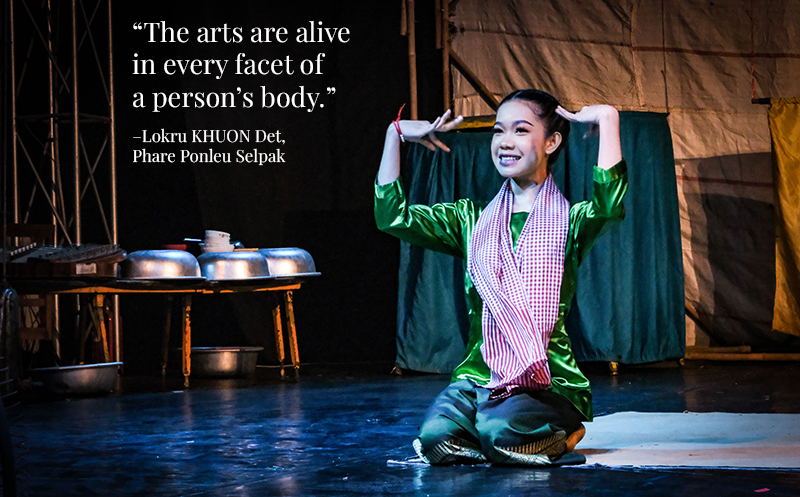
Photo Credit: Marco RICCIOLI
Conclusion
Understanding the value of the arts – why the arts matter – is important for us all. Art is at the core of both Phare Ponleu Selpak and the spirit of humanity as a whole.
These answers and discussions from the co-founders of Phare Ponleu Selpak shed light on the importance of art in the twenty-first century as a tool for healing and human development. Phare shares this brightness of the arts to students in Battambang and beyond because we back up our beliefs with action.
The arts aren’t just a part of life; they are life. Even for those who don’t pursue art as a profession, the arts help all of us see and experience life at a deeper, richer level.
Help the arts shine bright in Cambodia: Contribute to the ongoing work of Phare Ponleu Selpak and change the lives of children and youth in Battambang through the power of art, creativity, and imagination.
***
Special thanks to CHAN Rattanakoudom for helping translate all of these interviews from Khmer into English!


